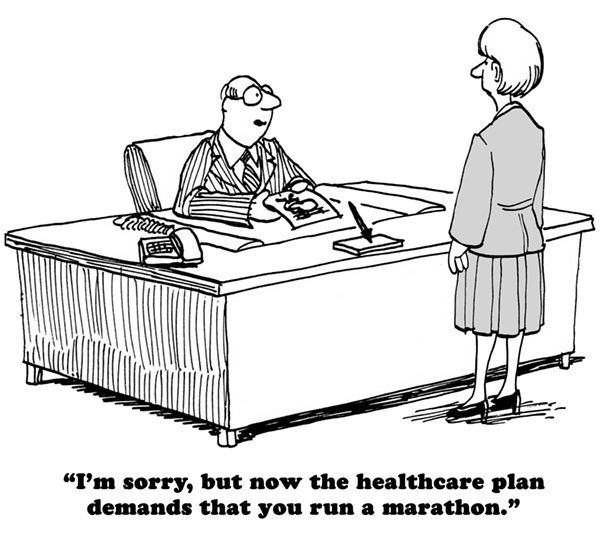Employers Are Poised to Lead Health Transformation
Next, to the U.S. government, employers are the largest buyer of healthcare products and services. That places a lot of responsibility – and affords a lot of opportunities – for employers to take the lead in helping shape the future of healthcare in America.
The Diagnosis: The Current State of Employer Healthcare is “Not-So-Well”
The healthcare Industry is losing the fight against the rising cost of healthcare. Given the current dysfunction in the system, employers are taking matters into their own hands and redefining “health” and “care” by creating benefits that embrace the notion that good health is more than healing the sick or managing chronic conditions. Good health goes beyond physical health and takes into account the whole person. An employee could be “not-so-well” due to financial pressures, relationship conflicts, work/life pressures or an aversion to seeking care. Through this lens, the path to improving employer health benefits lies in reframing the concept of health to truly meet the needs of employees.
The Lab Results: The Evidence Reveals Where the Problems Lie
While there is much discussion about the continually increasing costs of health insurance, there are other areas of healthcare that also impact an employer’s bottom line. The premium for those who receive insurance through their employer increased three percent in 2017, which outpaces inflation and wage increases. Sick employees cost employers $225.8 billion annually or $1,685 per employee. But, less discussed, yet even more impactful is presenteeism – being at work, but not performing up to par because of preoccupation with an illness, concern for a family member, etc. Presenteeism costs businesses 10 times more than absenteeism, with employees being unproductive (but in the office) an average of 57.7 days per year. Additionally, as America faces an opioid crisis, employers are shouldering an $81 billion burden from drug, alcohol and tobacco abuse – relating to crime, lost productivity and health.
The Prescription: Address Episodic, Chronic, Behavioral and Systemic Causes of “Not-So-Well” Health
In order to address “not-so-well health,” employers are partnering with stakeholders both in and outside of the ecosystem to redefine employer-sponsored healthcare. Below are some examples of employer-driven initiatives to bend the cost curve and improve health:
- Employers are partnering with hospital systems, such as University of Pittsburgh Medical Center (UPMC), to create their own health plans. These customized plans help employers control costs by tailoring plans to their specific needs and keeping care within a defined network.
- In 2010, Lowes made waves when they partnered with Cleveland Clinic to provide heart surgeries via bundled payments to employees, followed by a similar deal between Wal-Mart and six hospitals (including Cleveland Clinic, Mayo Clinic, Virginia Mason and others) in 2012. By paying hospitals a flat rate for the operation as well as any pre- and post-operative care, the employer ultimately saves money, which is why it is becoming more popular among employers such as Boeing and General Electric.
- Employers are also offering unique benefits to support physical and mental health. Fidelity’s “Well for Life” initiatives encourages healthy dining, health and wellness center expansion, tobacco-free campuses and physical activity for employees.
- Fitbit introduced their “Fitbit Group Health” program for corporate wellness in late 2016. Employers work directly with Fitbit to build custom programs for their employees. Since implementing the program, BP employees have taken more than 23 billion steps and Appirio employees were able to decrease their health insurance costs. Fitbit also integrates with Limeade, a mobile app for employers designed to increase employee engagement in their health by providing them customized activities, programs, and challenges.
- Similarly, mobile applications such as Hello Heart and Castlight help employers motivate employees to develop healthy habits. Hello, Heart focuses on helping employees track and control blood pressure, weight and other issues that impact heart health. Castlight more broadly tracks health habits, helps employees manage individual conditions and suggests providers.
The Prognosis: Employers Will Pave the Path to Comprehensive, Affordable and Effective Health Care Across America
Employers’ are looking to sources outside the traditional healthcare system to find ways to support employee health. At HLTH, you’ll hear from companies that are partnering with employers to provide out of the box solutions, such as Good Zing, a trusted community of health and wellness experts, and Wellist, which provides resources to patients and caregivers to fill non-clinical health needs. You’ll also hear from employers, such as Google, about how they are changing their overall approach to healthcare. The tech giant provides free healthy snacks and meals, has juice and coffee bars throughout their campus and offers on-site fitness classes and organized intramural sports. These initiatives promote employee well-being by encouraging them to get away from their desks and build relationships with their coworkers.
In our next blog, we’ll introduce you to the Employer Program at HLTH, which will feature the best benefit designs, services and programs employers are implementing to lower medical spend, improve quality of care, engage employees and, ultimately, align benefits offered to the value provided.
Be sure to check out our other healthcare blogs leading up to HLTH 2018 on May 6-9th at the Aria Resort and Casino in Las Vegas. Latest blogs include:

